K12 Professional Development 2016
Introduction
| All human and animal embryos go through very similar stages of early development.
The major difference appears to be how long it takes to reach each of these same stages.
We now also know that many of the underlying signals that regulate development are the same between these different species.
This page will introduce how we can compare the development of different animal embryos.
| Teacher Note
|
 This is currently only a draft designed to help K12 students understand comparative embryology. This is currently only a draft designed to help K12 students understand comparative embryology.
I am currently looking to simplify concepts and include images on this page. I am happy to receive feedback as too what you may like to be included here. I have also begun to add some simple exercises that can be used in class to help understand concepts in embryonic development and comparison. Note some of the links on this page leave the K12 notes section and may be beyond the level of your students, bookmark this page to easily return here. This page can be printed using the lefthand menu "Toolbox" or Printable version.
K12 Professional Development 2014
|
|
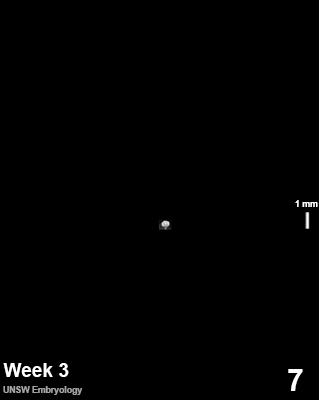
Click Here to play on mobile device
This movie shows human embryo development between week 3 to 8 after fertilisation.
|
Human Carnegie Stages
| Carnegie stages are named after the famous USA institute which began collecting and classifying embryos in the early 1900's. Human stages are based on the external and/or internal features of the embryo, and are not directly dependent on either age or size.
The human embryonic period proper is divided into 23 Carnegie stages covering the first 8 weeks after fertilisation (post-ovulation). This period is most of the first trimester and the second and third trimester is called Fetal Development and is mainly about growth.
Other features used in this classification include: ranges of age in days, number of segments (somites) present, and embryonic size (CRL, crown rump length).
Similar types of measurements are also used to stage how animal embryos develop. You can therefore compare other animal embryos each other and to human development by using these staging criteria.
|
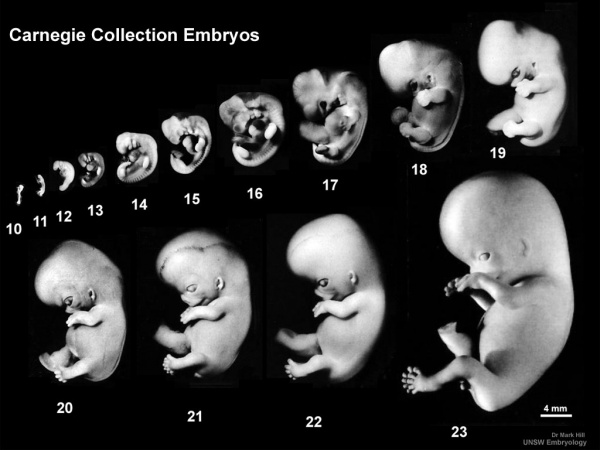 The Carnegie Embryos
The Carnegie Embryos
|
| Exercise 1 - Embryo Size
|
 How big is the human embryo? Download and Print the Worksheet How big is the human embryo? Download and Print the Worksheet
- Open the image above on a new page and draw up a table with 3 columns (Stage, Size, Week).
- Fill in the Stage column 10 to 23 from the information in the picture.
- Put a ruler or use piece of paper to mark the 4mm scale bar.
- Now measure the size of each embryo and fill in the second table column.
- Finally, get the students to look on the site to identify the range of stages that occur in each week and fill in the third table column.
|
Week 4 to 5
This is what the human embryo looks like at the end of week 4 and the beginning of week 5 development (called Carnegie stage 13) about half way through embryonic development.

|

|
| Measuring embryo size (Crown Rump Length)
|
Surface bulges (internal and external development)
|
- Links: Carnegie Stages
Species Comparison of Carnegie Stages
This table shows a comparison between different animal embryos and human embryos using the same staging criteria. Note that researchers have also developed embryo staging criteria that is specific to a single species.
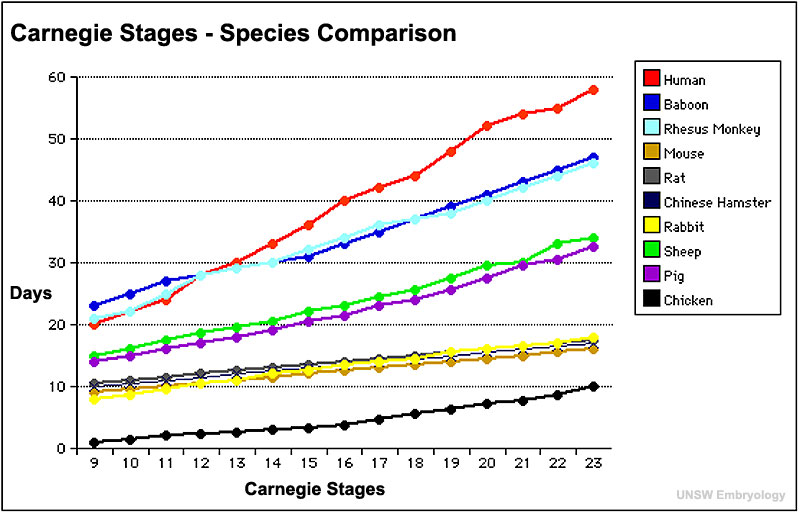
| Exercise 2 - Embryo Stages Comparison
|
 How long do different species take to reach the same stage of development? Download and Print the Worksheet How long do different species take to reach the same stage of development? Download and Print the Worksheet
- Download and print the linked file.
- Use the graph as a guide to complete the table.
- Colour the stage table to show each developmental week range for each species over the weeks 1 to 8. (The chicken has been given as an example in the table)
|
- Links: Animal Development | Comparative Development | Comparing Human Rat and Mouse
Human and Mouse Embryo
The images below show a human and mouse embryo that appear externally close to the same stage of development.
- Would you know which was which without the labels?
Human

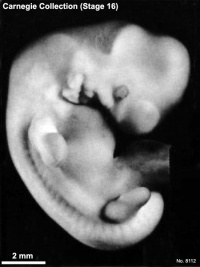
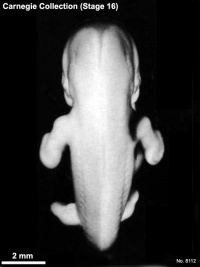
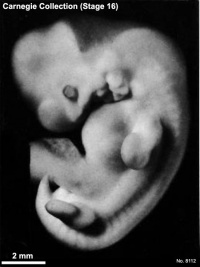
37 - 42 days, Week 6, 8 - 11 mm CRL (Carnegie stage 16)
Mouse
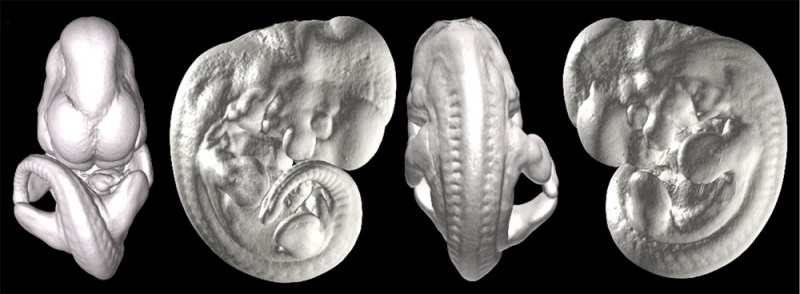
11.5 days, Week 2, 6 - 7 mm CRL (Theiler Stage 19)
| Exercise 3 - Embryo Comparison
|
 What features do different embryos share? Download and Print the Worksheet What features do different embryos share? Download and Print the Worksheet
The images below show the 4 views of the same embryo at about the same external stage of development.
- The human embryo - photographs from the historic Carnegie collection early 1900’s.
- The mouse embryo - recent magnetic resonance images (MRI) from a 2006 research paper.
- Both embryos are shown at about the same size (magnification). What is the actual difference in size between these two embryos?
- How many days difference are there between the mouse and human embryo to reach the same external appearance?
- Label the common external features you can identify on both embryos.
- What is the embryonic origin of the outer surface (skin) of both embryos?
|
Early Development
| Teacher Note
|
 Early Embryo Development. Early Embryo Development.
This process occurs before the above embryo stages. I have placed it after them on this page as it is a more abstract concept, while the external appearance of the embryos is easier for students to initially understand and relate too.
|
|
All vertebrate embryos initially form the same 3 germ layers.
During the third week of human embryonic development, the following layers form and will eventually differentiate and form specific adult tissues (some examples are shown in the cartoon and below).
Germ Layers:
- Ectoderm - epidermis of skin (outer layer of skin) and nervous system.
- Mesoderm - connective tissues (bone, muscle, cartilage, blood)
- Endoderm - lining of the gut, lungs, endocrine organs.
| Exercise 4 - Early Embryos
|
 What features are common in early development? What features are common in early development?
(worksheet under preparation, based on cartoon of germ cell layers)
Note
- These same three layers will form the same adult tissues in all mammalian, and more widely vertebrate (animals with a backbone), embryos.
- The term "germ layers" refers to the fact that cell layers will form all adult tissues.
- The term should not be confused with "germ cells", which refers to the cells that will form either eggs or spermatozoa.
- The term "derm" means skin as in a layer.
- The layers form by a process called gastrulation.
- This is therefore called the gastrula stage.
- These are temporary layers and do not exist as layers in either the later embryo or adult.
- Gastrulation will occur at different times in different species embryos.
- In humans, this occurs about 3 weeks after fertilisation and also after implantation in the uterus.
|
|
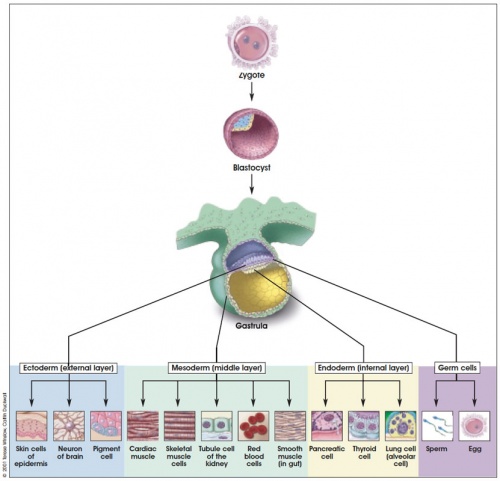
|
Limb Comparative Anatomy
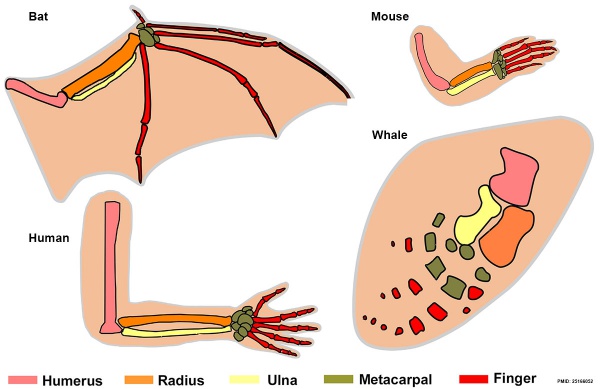
This cartoon shows the comparative anatomy of bones within the upper limb of 4 different species.
Each limb is significantly different in size and function, but all contain the same basic skeletal structures.
Animal Development
The table below lists the approximate development time for a large number of different animals, ranging from the opossum at 12 days to the elephant at 660 days.
| Animal Development Time
|
| Animal
|
Average Days
|
| Bear (Black)
|
210
|
| Bison
|
270
|
| Budgerigar
|
18
|
| Camel
|
410
|
| cat
|
65
|
| cow
|
281
|
| chicken
|
21
|
| Chimpanzee
|
236
|
| Chinchilla
|
111
|
| Coyote
|
63
|
| deer (Mule)
|
200
|
| dog
|
63
|
| Donkey
|
365
|
| Duck
|
28
|
| Duck (Muscovy)
|
35
|
| elephant
|
660
|
| Elk, Wapiti
|
255
|
| Ferret
|
42
|
| Finch
|
14
|
| Fox
|
52
|
| Giraffe
|
425
|
| goat
|
150
|
| Goose
|
28
|
| Gorilla
|
270
|
| Guinea fowl
|
28
|
| guinea pig
|
68
|
| Hare
|
36
|
| Hippopotamus
|
240
|
| horse
|
338
|
| Human
|
274
|
| Leopard
|
95
|
| Lion
|
108
|
| Llama
|
350
|
| Marmoset
|
150
|
| Mink (European)
|
41
|
| monkey (Macaque)
|
180
|
| Moose
|
240
|
| mouse
|
20
|
| Muskox
|
255
|
| Muskrat
|
29
|
| Nutria, Coypu
|
130
|
| opossum
|
12
|
| Otter
|
285
|
| Panther
|
90
|
| Parrot
|
26
|
| Pheasant
|
24
|
| Pig
|
114
|
| Pigeon
|
18
|
| Porcupine
|
210
|
| Pronghorn
|
230
|
| Quail
|
16
|
| rabbit
|
31
|
| Raccoon
|
63
|
| rat
|
21
|
| Reindeer
|
225
|
| Rhinoceros (African)
|
480
|
| Seal
|
330
|
| sheep
|
150
|
| Shrew
|
20
|
| Skunk
|
63
|
| Squirrel (Gray)
|
40
|
| Swan
|
35
|
| Tapir
|
390
|
| Tarsier
|
182
|
| Tiger
|
103
|
| Turkey
|
28
|
| Walrus
|
450
|
| whale (Sperm)
|
450
|
| Wolf
|
63
|
| Woodchuck
|
31
|
|
Animal Notes and Table Data Sources
- Each animal species has different variations +/- the average values shown in the table.
- Gestation is the carrying of an animal embryo or fetus inside a female viviparous animal. Except in the case of human gestational age GA.
- Incubation is the laying of an egg (birds, reptiles, monotremes) with development occurring outside the female animal.
See also - Timeline Comparisons
Additional Data Sources
- Theiler K. The House Mouse: Atlas of Mouse Development (1972, 1989) Springer-Verlag, NY. Online
- Witschi E. Rat Development. In: Growth Including Reproduction and Morphological Development. (1962) Altman PL. and Dittmer DS. ed. Fed. Am. Soc. Exp. Biol., Washington DC, pp. 304-314.
- The Genetics of the Dog. E Ostrander, E. and Ruvinsky, A. ISBN: 9781845939403 (2012)
- Merck Veterinary Manual. Aiello, S.E. and Moses, M.A. (ed) ISBN: 0911910506 (2013) Online
- Witschi, E. (1962) Development: Rat. In: Growth Including Reproduction and Morphological Development. Altman, P. L. , and D. S. Dittmer, ed. Fed. Am. Soc. Exp. Biol., Washington DC, pp. 304-314.
|


| Teacher Note
|
 Currently only a series of related images. Currently only a series of related images.
I am writing explanatory notes and associated exercises for this section when I have some spare time. You can also let your students look at the animal pages designed by my students back in 2009. Each page includes images of the embryos and a timeline of development for each animal embryo.
These are university undergraduate student designed pages describing the development of specific animal embryos.
ANAT2341 group projects
Project 1 - Rabbit | Project 2 - Fly | Project 3 - Zebrafish | Group Project 4 - Mouse | Project 5 - Frog | Students Page | Animal Development
|
| Teacher Note
|
 Comparative Embryology - Links out to other resources. Comparative Embryology - Links out to other resources.
K12 Student worksheets
These worksheets have been designed as short teaching exercises that can be downloaded and printed (PDF version) or modified by the teacher (Word version) for use in class. Biology curriculum may vary between classes, state and country as a Teacher please check the materials closely before using for teaching purposes.
- Worksheet content should not be used for commercial purposes or republished online.
Worksheets PDF: Comparative Embryology - Embryo Size | Embryo Stages | Embryo Species
Worksheets Word: Comparative Embryology - Embryo Size | Embryo Stages | Embryo Species
Additional worksheets are currently being developed.
These links below are not yet organised in a way that students can easily use (content level and navigation) bookmark this current page or use the browser back button.
Look through the stages and tables and think about designing exercises comparing the different species.
|
Developmental Misconceptions
Many of these are truely historic, and while essentially wrong, science works through testing these alternate theories, and is some cases some can even be partially correct.
| Preformationist Theory
|
| N. Hartsoeker (1694) image of how he imagined a sperm would look if it contained a preformed individual.
Note that Hartsoeker later rejected this preformationist view, carrying out calculations of size that showed that if all of the animals of any species had been enclosed in the first male or female, those animals that now inhabit the earth would have to be infinitely and incomprehensively small.
This was replaced by the "epigenesis theory", the organism form arises gradually, changing shape and acquiring its adult parts over time.
|
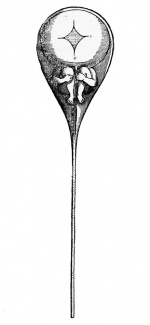
|
| Recapitulation Theory
|
| Ernst Haeckel (1834 – 1919) "ontogeny recapitulates phylogeny" claimed that an individual organism's biological development (ontogeny), parallels and summarises its species evolutionary development (phylogeny). First a single-celled organism, then evolve into a fish, then an amphibian, then a reptile, then a bird, and finally reach a mammal.
Current developmental biology shows that animals follow similar developmental programs, but do not go through a "species change" during development.
|
| Ovary Germinal Epithelium
|
| The epithelium surrounding the ovary was originally thought to provide the source of follicles and oocytes and therefore called the "germinal epithelium".
Current developmental biology shows that this is not the source of primordial germ cells or follicle components, but is a cuboidal epithelium overlying a dense connective tissue layer (tunica albuginea).
|
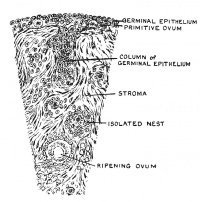
|
| Genetic Theory
|
| Genetics - "genes determine our physiology and chemical behaviour".
While genetics is essentially correct, we now know that inheritance mechanisms exist outside the DNA sequence of our genes and include DNA methylation, histone modification, and those of the microRNA machinery.
Molecular Development - Epigenetics
|
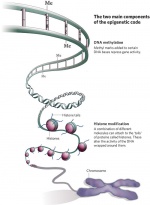
|
Cite this page: Hill, M.A. (2024, May 1) Embryology K12 Human and Other Animal Development. Retrieved from https://embryology.med.unsw.edu.au/embryology/index.php/K12_Human_and_Other_Animal_Development
- What Links Here?
- © Dr Mark Hill 2024, UNSW Embryology ISBN: 978 0 7334 2609 4 - UNSW CRICOS Provider Code No. 00098G

 How big is the human embryo? Download and Print the Worksheet
How big is the human embryo? Download and Print the Worksheet


 How long do different species take to reach the same stage of development? Download and Print the Worksheet
How long do different species take to reach the same stage of development? Download and Print the Worksheet
 What features do different embryos share? Download and Print the Worksheet
What features do different embryos share? Download and Print the Worksheet
 Currently only a series of related images.
Currently only a series of related images.
 Comparative Embryology - Links out to other resources.
Comparative Embryology - Links out to other resources.













